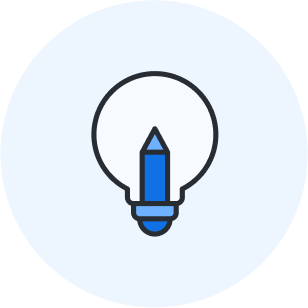
Maximizing AI’s potential in the workplace: New data highlights the barriers and benefits
Reading time: about 6 min
When it comes to AI, one thing’s for sure: It has the power to transform the workforce. But just how it can do so isn’t so clear. What can organizations do to realize the full potential of AI? And what’s holding some back?
To shed light on the many unknowns surrounding AI in the workforce, Lucid conducted a survey of more than 2,500 knowledge workers globally. We’ve uncovered the top benefits, use cases, and gaps surrounding AI in the workplace. The biggest gap of all? The perception gap between how executives and employees view and apply AI.
The data shows that, for organizations to reap the full benefits of AI, they must understand what barriers are holding back their workforce and work to close this gap.

The promise of AI: What’s driving AI adoption?
AI adoption in organizations has soared due to AI’s potential to help teams work more efficiently and effectively. Over 50% of respondents believe that AI will save them three or more hours a week.
The top drivers of AI adoption reported in our survey were:
- Improved productivity (cited by 62% of respondents)
- Automation of repetitive tasks (49%)
- Integration with existing workflows (41%)
- Cost savings with consolidated tech stack (40%)
- Enhanced communication and decision-making (38%)
How do these desired outcomes stack up against the actual outcomes reported? Survey respondents cited already experiencing the following benefits from AI:
- Increased productivity (cited by 43% of respondents)
- Improved accuracy and reduced errors (30%)
- Faster documentation that aligns teams (27%)
- Easier time sorting/organizing ideas (27%)
- Better decision-making (23%)
It’s clear that while organizations are already seeing some of the positive effects of AI, there is plenty of room for improvement.
Top use cases of AI in the workplace
To understand how workers can get more out of AI, we need to understand how they’re currently using it.
The data shows that over a third of workers are familiar with and use AI for basic use cases, with the top being:
- Generating ideas (39%)
- Creating content (37%)
- Communicating summaries (33%)
- Finding documentation (31%)
While these are all fantastic ways to save time with AI, there are far more opportunities to use AI than organizations are giving it credit for. Only 26% of respondents cite using AI for synthesizing ideas or research, and only 19% are using AI for designing diagrams. By looking for ways to implement AI across the entire workflow, organizations may be able to save time and effort in places they wouldn’t have thought possible.
Regardless of how workers are using AI, most (58%) believe that human input should always be primary, with AI as a support tool.

How do workers feel about the rise of AI in the workplace?
Overall, the workforce is generally optimistic about AI. Over half (63%) of respondents believe AI will positively impact their work-life balance, and 62% feel it will lead to greater job satisfaction.
However, this data is disproportionately skewed toward leadership, with 68% of executives believing AI will positively impact their job satisfaction, compared to 53% of managers and only 37% of entry-level workers.
This sentiment translates into AI usage as well. Executives are leading the charge, with 83% of executives citing using AI-powered collaboration tools, compared to only 42% of entry-level workers.
Executives are also embracing AI more frequently for their daily tasks and collaboration (54%), while entry-level workers lag behind (21%). In fact, nearly half (48%) of entry-level workers use AI tools less than once a month. This data indicates that while executives may be excited to limit their execution tasks and spend more time on strategic work, the people doing the work are far less eager.
So, what’s holding employees back from fully embracing AI? Let’s take a look.
Top challenges and concerns in AI adoption
It’s no surprise that such a powerful new technology would come with its share of challenges. Here are the main barriers organizations face as they determine how to optimize AI for their workforce.
Data security and privacy concerns
Not surprisingly, security and privacy were top of mind among our survey respondents, with 40% expressing concerns about data security with AI. The good news is that 88% of companies are actively implementing strict guidelines to safeguard their business and employees.
The data revealed greater discrepancies regarding policy implementation, though. While 67% of respondents think clear guidelines and policies are necessary to ensure the responsible use of AI, only 29% of entry-level employees are confident that their company has these in place. However, 70% of executives say their company has established these policies, indicating the need to make these guidelines more transparent or communicate them more frequently.

How AI changes the threat landscape
Hear Lucid’s security experts discuss the evolution of cyber threats and what this means for organizations.
Watch the on-demand webinarAn AI skills gap
One of the reasons workers may not be using AI is because they don’t know how.
Over a third (33%) of our survey respondents cited the need for continuous training to be a top challenge when implementing AI. What’s more, 41% of entry-level workers feel hardly or not at all knowledgeable about AI-powered features, compared to just 10% of executives.
Given how quickly the AI landscape changes, it’s clear that workers could use more education and training to stay in the know. Only 27% are receiving work-sponsored AI training, and while executives may be inclined to engage in independent AI education several times a week (39%), only 13% of entry-level employees and 20% of managers are doing the same.

The top AI skills every worker should know
Discover the AI skills that are essential for the workplace and how to learn them.
Read moreResistance to change
AI represents a significant change, and many employees may not be ready to learn a new technology or tool. In fact, 37% of knowledge workers report feeling hesitant about using AI-powered collaboration tools, with 26% indicating that the reason they’re hesitant about AI is simply because they prefer traditional methods and tools.
It’s also worth noting that roughly one-third (33%) of respondents are worried AI could make their job replaceable.
Given this data, it’s not surprising that 33% of respondents cite resistance to change as a top challenge when implementing AI.
Executives will need to practice change management principles, cast a clear vision around the benefits of AI, and listen to their employees' concerns to help their workforce embrace the change.
Final thoughts
Whether you feel nervous, excited, or cautiously optimistic about AI, there’s no doubt it’s already impacting the workplace. After all, AI shows promise in the workplace—from increasing productivity to enhancing decision-making—but these benefits are muted by concern, reluctance, and lack of knowledge.
To get the most out of AI, executives can take intentional steps to bring the rest of the organization with them on the AI journey, such as providing support and education about the most impactful ways to use AI.

Applying AI impactfully
Learn how to get more out of AI by applying it to common business challenges.
Learn moreAbout Lucid
Lucid Software is the leader in visual collaboration and work acceleration, helping teams see and build the future by turning ideas into reality. Its products include the Lucid Visual Collaboration Suite (Lucidchart and Lucidspark) and airfocus. The Lucid Visual Collaboration Suite, combined with powerful accelerators for business agility, cloud, and process transformation, empowers organizations to streamline work, foster alignment, and drive business transformation at scale. airfocus, an AI-powered product management and roadmapping platform, extends these capabilities by helping teams prioritize work, define product strategy, and align execution with business goals. The most used work acceleration platform by the Fortune 500, Lucid's solutions are trusted by more than 100 million users across enterprises worldwide, including Google, GE, and NBC Universal. Lucid partners with leaders such as Google, Atlassian, and Microsoft, and has received numerous awards for its products, growth, and workplace culture.
Related articles
The top AI adoption challenges (+ solutions) in the workplace
Get expert tips for overcoming three of the greatest AI adoption challenges workers face today.
Using AI throughout a project workflow: 5 common challenges solved by AI
Here are five common business challenges and how AI helps solve them.
The dos and don’ts of using AI in the workplace
Here are some dos and dont’s of using AI in the workplace you can start implementing today.
6 AI skills everyone should know for the workplace and how to learn them
These are the top 6 AI skills everyone should know and how you can learn them.
